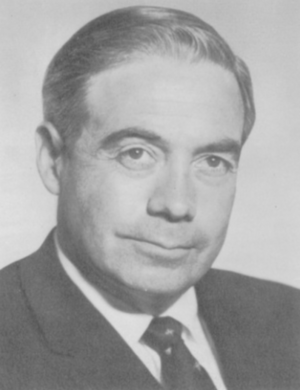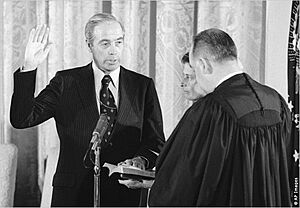William Scranton facts for kids
Quick facts for kids
William Scranton
|
|
|---|---|
 |
|
| 13th United States Ambassador to the United Nations | |
| In office March 15, 1976 – January 19, 1977 |
|
| President | Gerald Ford |
| Preceded by | Daniel Patrick Moynihan |
| Succeeded by | Andrew Young |
| 38th Governor of Pennsylvania | |
| In office January 15, 1963 – January 17, 1967 |
|
| Lieutenant | Raymond P. Shafer |
| Preceded by | David Lawrence |
| Succeeded by | Raymond P. Shafer |
| Member of the U.S. House of Representatives from Pennsylvania's 10th district |
|
| In office January 3, 1961 – January 3, 1963 |
|
| Preceded by | Stanley Prokop |
| Succeeded by | Joe McDade |
| Personal details | |
| Born |
William Warren Scranton
July 19, 1917 Madison, Connecticut, U.S. |
| Died | July 28, 2013 (aged 96) Montecito, California, U.S. |
| Political party | Republican |
| Spouse |
Mary Lowe Chamberlain
(m. 1942) |
| Children | 4, including William |
| Relatives | Scranton family |
| Education | Yale University (BA, LLB) |
| Military service | |
| Allegiance | United States |
| Branch/service | |
| Years of service | 1941–1945 |
| Rank | |
William Warren Scranton (born July 19, 1917 – died July 28, 2013) was an American politician and diplomat. He was a member of the Republican Party. Scranton served as the 38th governor of Pennsylvania from 1963 to 1967. Later, he became the United States Ambassador to the United Nations from 1976 to 1977. Many people still remember his strong leadership today.
William W. Scranton was born into the well-known Scranton family. He studied law at Yale Law School. During World War II, he served in the United States Army Air Corps. After the war, he worked as a lawyer. He also became active in the Republican Party in Pennsylvania. In 1960, he was elected to the United States House of Representatives. He was known for being a moderate, meaning he held views that were not extreme. In 1962, he won the election to become governor of Pennsylvania. He defeated Democrat Richardson Dilworth.
As governor, Scranton made big changes to Pennsylvania's education system. This included creating the state's community college system. In 1964, he tried to become the Republican candidate for president. However, Barry Goldwater won the nomination instead. Scranton could not run for governor again in 1967 due to term limits. But he stayed involved in politics. He led a special group called the President's Commission on Campus Unrest. He also helped President Gerald Ford when Ford took office.
Contents
Early Life and Family Connections
William Scranton was born on July 19, 1917. His family was on vacation in Madison, Connecticut at the time. His father, Worthington Scranton, was a rich businessman in Pennsylvania. He led the Scranton Gas and Water Company. His mother, Marion Margery (Warren) Scranton, was also involved in politics. She was a member of the Republican National Committee for over 20 years.
Even though his mother was active in politics, she did not want him to join. William had asthma as a child. She worried that the stress of political campaigns would be bad for his health. She passed away just before he was elected to Congress in 1960.
The city of Scranton, Pennsylvania was founded by members of the Scranton family. These included George W. Scranton and his brother Selden. William Scranton was also related to other important people. His grand-uncle, Joseph A. Scranton, was a Representative from Pennsylvania. His aunt by marriage was the wife of David Davis. David Davis was a U.S. Supreme Court Justice and a friend of President Abraham Lincoln.
William Scranton lived with his parents for many years at Marworth. This was a large estate in Dalton, Pennsylvania. He inherited the estate after his parents died. In 1976, Scranton and his wife hosted a party there. Important guests like U.N. Secretary General Kurt Waldheim attended.
Education and Military Service
William Scranton started his schooling at the Scranton Country Day School. His parents had founded this school. He also attended the Fessenden School and the Hotchkiss School. In 1939, Scranton graduated from Yale University. While at Yale, he was part of the Yale Political Union. He was also in the Chi Psi fraternity. There, he became friends with Gerald Ford, who later became a U.S. President.
He began studying at Yale Law School in 1939. However, he left before World War II started. He joined the United States Army Air Corps. During the war, he served as an Air Transport Command pilot. He did not fight in combat. Instead, he helped with aircraft and pilot training. He was stationed in South America, Africa, and Asia.
On July 6, 1942, he married Mary Lowe Chamberlain. They had four children: Susan, William Worthington, Joseph Curtis, and Peter Kip. He left the military as a captain. He continued to serve in the U.S. Air Force Reserves for 20 years. After the war, he finished his law studies at Yale. He graduated in 1946 and became a lawyer in Pennsylvania.
Starting His Career in Politics
After the war, Scranton worked as a lawyer. Then he moved into the business world. He became successful in several companies in Pennsylvania. In 1949, he joined International Correspondence Schools. He was the Vice President for legal matters. He left in 1954 but later served on their board.
In the 1950s, he became active in the Republican Party. President Dwight Eisenhower noticed him. In 1959, Eisenhower made Scranton a special assistant. He worked for the U.S. Secretary of State, John Foster Dulles, and later Christian Herter. Scranton served for about a year. Then he left to run for Congress.
Scranton was well-known because of his family. This helped him win his election in 1960. He won by 17,000 votes against incumbent Stanley A. Prokop. This was in a district that usually voted for Democrats. Scranton represented Pennsylvania's 10th Congressional District. He served in the U.S. House of Representatives from 1961 to 1963. Even as a new Republican, he quickly became known as a moderate. He supported many of President John F. Kennedy's ideas. This included laws for the Civil Rights Movement and the Peace Corps. The news media called him a "Kennedy Republican."
Becoming Governor of Pennsylvania
In 1962, the Republican Party in Pennsylvania needed a change. They had lost the last two governor elections. They believed a moderate like Scranton could win support from both parties. He ran for governor against Richardson Dilworth, who was the mayor of Philadelphia. Raymond Shafer joined Scranton as his running mate. Shafer would later become governor after Scranton.
The campaign was very tough. But Scranton and Shafer won by a large number of votes. They defeated their opponents by almost half a million votes. Over 6.6 million votes were cast in total.
Governor's Achievements
Under Scranton's leadership, Pennsylvania's economy got better. Unemployment dropped from 7.5 percent to 3.6 percent. The average weekly pay for blue-collar workers increased by nearly $23. This happened over his four years in office. State law at the time limited governors to one term. Scranton increased state government spending to a record $5.21 billion. His predecessor had spent $3.78 billion.
He also signed important laws for education. These laws created the state's community college system. They also set up the state board of education and the Higher Education Assistance Agency. He started a program to promote Pennsylvania's products and services. This helped the state in national and international markets.
In 1964, there were protests in Chester, Pennsylvania. These were about schools being separated by race. George Raymond of the NAACP and Stanley Branche led these protests. Governor Scranton created the Pennsylvania Human Relations Commission. This commission helped address the issues. The protests stopped while the commission held hearings.
A Big Search in Pennsylvania
While Scranton was governor, Pennsylvania had its largest manhunt ever. On May 11, 1966, Peggy Ann Bradnick was kidnapped. This happened near Shade Gap. The Pennsylvania State Police, FBI agents, local police, and volunteers searched the mountains. On May 17, the kidnapper, William Diller Hollenbaugh, shot and killed FBI Agent Terry Ray Anderson. The next day, Hollenbaugh shot and wounded Deputy Sheriff Francis Sharpe. There was a shootout, and Hollenbaugh was killed. Peggy Ann Bradnick was rescued safely.
1964 Presidential Race
Scranton did not plan to run for President in 1964 at first. But many moderate Republicans wanted him to. They saw him as an alternative to the conservative candidate, Senator Barry Goldwater. Some Republicans worried that Goldwater's strong views would lead to a loss. The campaign of another candidate, Nelson Rockefeller, had lost momentum.
Scranton first said he would not run. But he later changed his mind on June 12, 1964. He won support from ten state groups. However, Goldwater won the nomination on the first try. William E. Miller was chosen as the Vice President candidate.
Later Career and Public Service
Under Pennsylvania law at the time, Scranton could only serve one term as governor. He could not run for reelection in 1966. That same year, he said he would never seek elected office again. After being governor, Scranton helped write a new constitution for the state. This new constitution allowed future governors to serve a second term.
After Richard Nixon became President in 1968, he asked Scranton to be Secretary of State. Scranton said no. He did serve as a special envoy to the Middle East. He suggested that the Nixon Administration should be "more evenhanded" in the Middle East. Some people did not like this idea.
After Nixon resigned in 1974, Scranton helped President Gerald Ford during his transition. Scranton also worked in the business world. He served on the boards of several big American companies. These included IBM and The New York Times. He was also president of Northeastern National Bank and Trust Company.
In 1976, President Ford chose Scranton to be the United States Ambassador to the United Nations. He was known for his calm approach to diplomacy and his interest in human rights. He earned a lot of respect during his short time in office. Some Republicans wanted Scranton to be Ford's running mate in the 1976 presidential election. But Ford chose Senator Robert Dole instead. After his time as UN Ambassador, Scranton retired to his home in Dalton, Pennsylvania.
Scranton's son, William Scranton III, also became a politician. He served as Lieutenant Governor of Pennsylvania. He ran for governor in 1986 but did not win.
In 1997, Scranton was elected to the American Philosophical Society.
Death
William Scranton passed away on July 28, 2013. He was 96 years old. He died from a cerebral hemorrhage at a retirement community in Montecito, California. His wife, Mary Scranton, died on December 26, 2015, at age 97. She had Alzheimer's disease.
See also
- Scranton family




